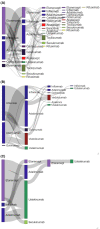Switching TNFα inhibitors: Patterns and determinants
- PMID: 34302442
- PMCID: PMC8305431
- DOI: 10.1002/prp2.843
Switching TNFα inhibitors: Patterns and determinants
Abstract
The aim of this study was to assess switching patterns and determinants for switching in patients initiating TNFα inhibitor (TNFα-i) treatment. Patients were included who started TNFα-i treatment between July 1, 2012 and December 31, 2017, from three Dutch hospitals, and were diagnosed with rheumatic diseases (RD), inflammatory bowel disease (IBD), or psoriasis. Outcomes were switching, defined as initiating another biological; switching patterns including multiple switches until the end of follow-up; determinants for first switch, assessed using multivariate logistic regression. A total of 2228 patients were included (median age 43.3 years, 57% female), of which 52% (n = 1155) received TNFα-i for RD, 43% (n = 967) for IBD, and 5% (n = 106) for psoriasis. About 16.6% of RD patients, 14.5% of IBD patients, and 16.0% of psoriasis patients switched at least once, mainly to another TNFα-i. TNFα-i dose escalation (OR 13.78, 95% CI 1.40-135.0) and high-dose corticosteroids initiation (OR 3.62, 95% CI 1.10-12.15) were determinants for switching in RD patients. TNFα-i dose escalation (OR 8.22, 95% CI 3.76-17.93), immunomodulator initiation/dose escalation (OR 2.13, 95% CI 1.04-4.34), high-dose corticosteroids initiation (OR 6.91, 95% CI 2.81-17.01) and serum concentration measurement (OR 5.44, 95% CI 2.74-10.79) were determinants for switching in IBD patients. Switching biological treatment occurred in about one in six patients. RD patients with TNFα-i dose escalation and/or high-dose corticosteroids initiation were more likely to switch. IBD patients with TNFα-i or immunomodulator initiation/dose escalation, high-dose corticosteroids initiation or serum concentration measurement were more likely to switch. These findings might help clinicians anticipating switching in TNFα-i treatment.
Keywords: biological products; drug utilization; inflammatory bowel diseases; pharmacoepidemiology; rheumatology; tumor necrosis factor inhibitors.
© 2021 The Authors. Pharmacology Research & Perspectives published by British Pharmacological Society and American Society for Pharmacology and Experimental Therapeutics and John Wiley & Sons Ltd.
Conflict of interest statement
The authors declare they have no conflict of interest.
Figures


References
-
- 2018 EPAREA via http://www.ema.europa.eu/docs/en_GB/document_library/EPAR.‐_Product_Info.... on 17 J. Enbrel ‐ Summary of product characteristics.
-
- 2018 EPARRA via http://www.ema.europa.eu/docs/en_GB/document_library/EPAR.‐_Product_Info.... on 17 J. No Title.
-
- 2018 EPARHA via http://www.ema.europa.eu/docs/en_GB/document_library/EPAR.‐_Product_Info.... on 17 J. No Title.
-
- 2018 EPARCA via http://www.ema.europa.eu/docs/en_GB/document_library/EPAR.‐_Product_Info.... on 17 J. No Title.
-
- 2018 EPARSA. via http://www.ema.europa.eu/docs/en_GB/document_library/EPAR.‐_Product_Info.... on 17 J. No Title.
Publication types
MeSH terms
Substances
LinkOut - more resources
Full Text Sources
Medical
Miscellaneous

